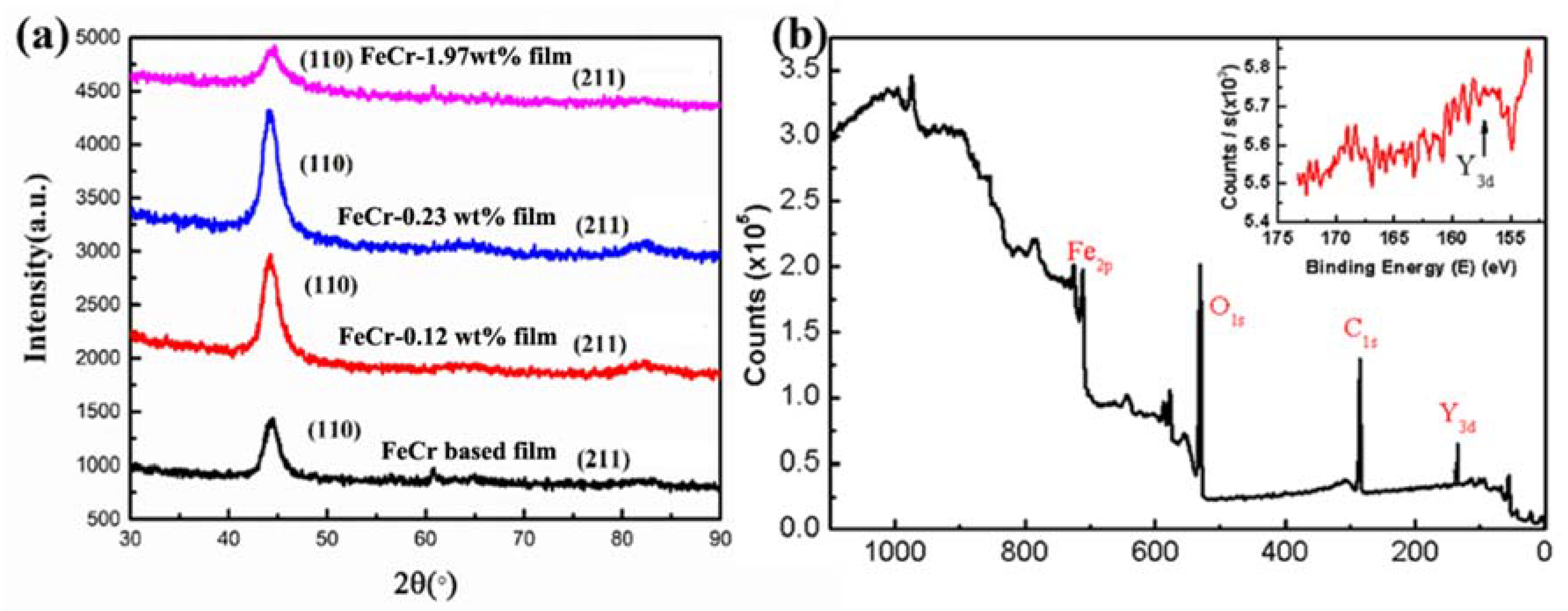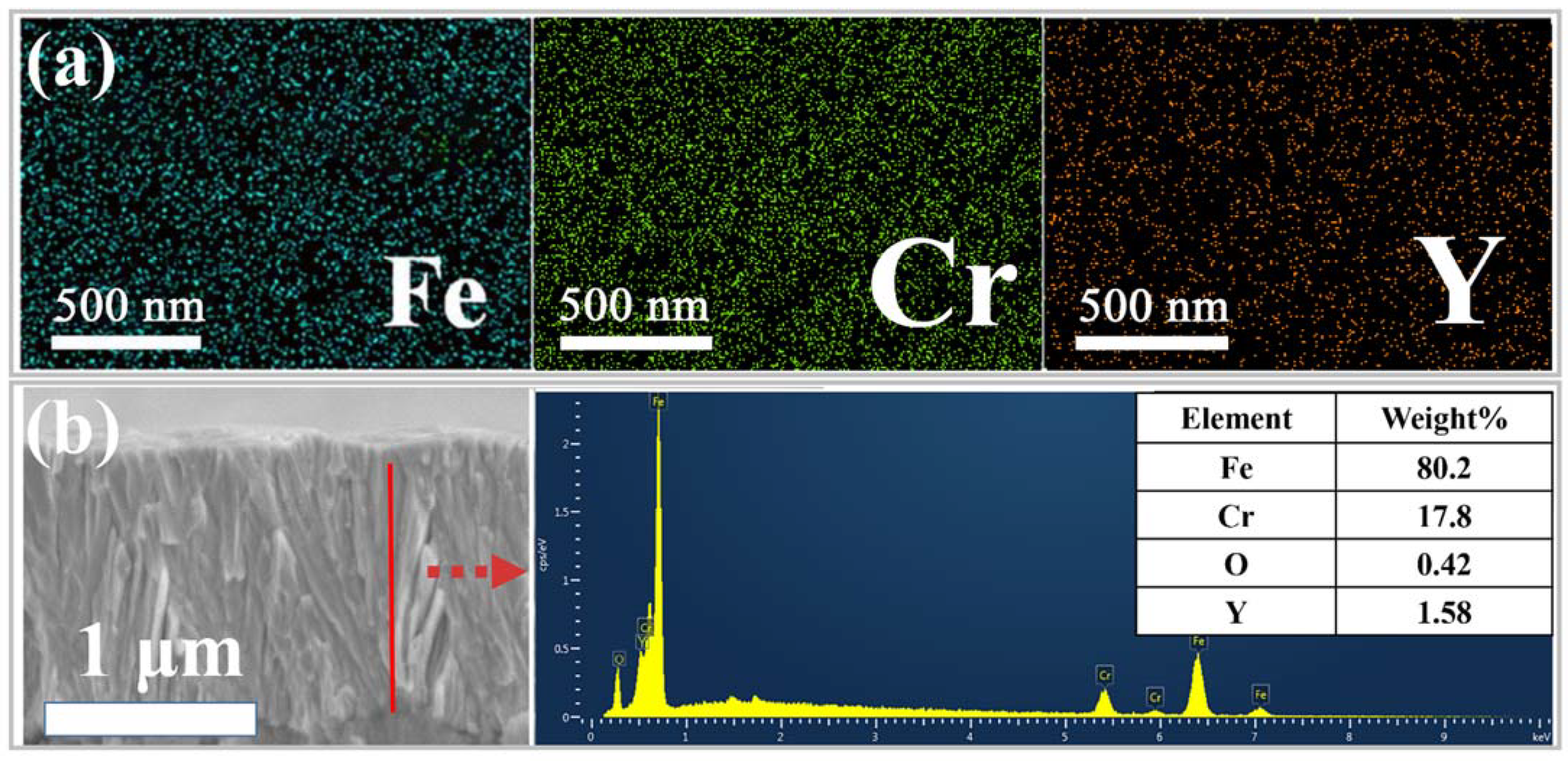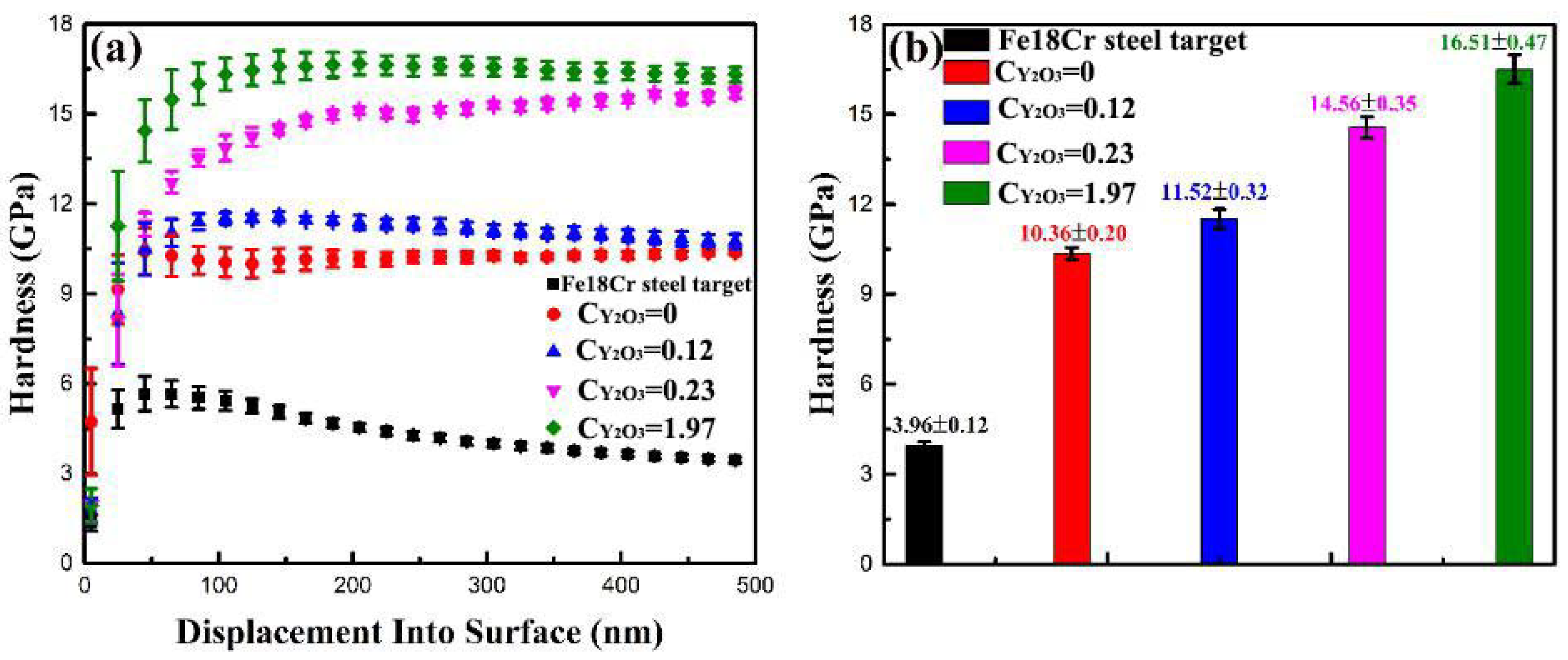Effect of Nano-Y2O3 Content on Microstructure and Mechanical Properties of Fe18Cr Films Fabricated by RF Magnetron Sputtering
Abstract
:1. Introduction
2. Experimental
3. Results and Discussion
4. Conclusions
- (1)
- The coherent domain size of ODS-FeCr-based film is about 7~12 nm, and it decreases with an increase in Y2O3 content.
- (2)
- The addition of Y2O3 can obviously enhance the hardness of FeCr-based films, resulting in an extremely high value of 16.5 GPa.
- (3)
- The strengthening mechanism was from the nano-Y2O3 particle dispersion strengthening as well as the grain refinement strengthening.
Author Contributions
Funding
Institutional Review Board Statement
Informed Consent Statement
Data Availability Statement
Conflicts of Interest
References
- Zinkle, S.J. Challenges in Developing Materials for Fusion Technology-Past, Present and Future. Fusion Sci. Technol. 2013, 64, 65–75. [Google Scholar] [CrossRef]
- Mansur, L.; Rowcliffe, A.; Nanstad, R.; Zinkle, S.; Corwin, W.; Stoller, R. Materials needs for fusion, Generation IV fission reactors and spallation neutron sources–similarities and differences. J. Nucl. Mater. 2004, 329, 166–172. [Google Scholar] [CrossRef]
- Beeler, B.; Asta, M.; Hosemann, P.; Grønbech-Jensen, N. Effects of applied strain on radiation damage generation in body-centered cubic iron. J. Nucl. Mater. 2015, 459, 159–165. [Google Scholar] [CrossRef] [Green Version]
- Judge, C.D.; Gauquelin, N.; Walters, L.; Wright, M.; Cole, J.I.; Madden, J.; Botton, G.A.; Griffiths, M. Intergranular fracture in irradiated Inconel X-750 containing very high concentrations of helium and hydrogen. J. Nucl. Mater. 2015, 457, 165–172. [Google Scholar] [CrossRef]
- Zhang, H.; Zhang, C.; Yang, Y.; Meng, Y.; Jang, J.; Kimura, A. Irradiation hardening of ODS ferritic steels under helium implantation and heavy-ion irradiation. J. Nucl. Mater. 2014, 455, 349–353. [Google Scholar] [CrossRef]
- Gao, C.; Doyle, W.D.; Shamsuzzoha, M. Quantitative correlation of phase structure with the magnetic moment in rf sputtered Fe-N films. J. Appl. Phys. 1993, 73, 6579–6581. [Google Scholar] [CrossRef]
- Little, E.A.; Stow, D.A. Void-swelling in irons and ferritic steels_ II. An experimental survey of materials irradiated in a fast reactor. J. Nucl. Mater. 1979, 87, 25–39. [Google Scholar] [CrossRef]
- Group, T. Pump limiter experiment in the TFR Tokamak. J. Nucl. Mater. 1987, 145, 819–823. [Google Scholar]
- Kapoor, S.S. Accelerator-driven sub-critical reactor system (ADS) for nuclear energy generation. Indian Acad. Sci. 2002, 59, 941–950. [Google Scholar] [CrossRef]
- Trinkaus, H.; Singh, B.N. Helium accumulation in metals during irradiation—Where do we stand? J. Nucl. Mater. 2003, 323, 229–242. [Google Scholar] [CrossRef]
- Hasegawa, A.; Ejiri, M.; Nogami, S.; Ishiga, M.; Kasada, R.; Kimura, A.; Abe, K.; Jitsukawa, S. Effects of helium on ductile-brittle transition behavior of reduced-activation ferritic steels after high-concentration helium implantation at high temperature. J. Nucl. Mater. 2009, 386, 241–244. [Google Scholar] [CrossRef]
- de Castro, V.; Leguey, T.; Monge, M.; Munoz, A.; Pareja, R.; Amador, D.; Torralba, J.; Victoria, M. Mechanical dispersion of Y2O3 nanoparticles in steel EUROFER 97: Process and optimization. J. Nucl. Mater. 2003, 322, 228–234. [Google Scholar] [CrossRef]
- Ukai, S.; Kaito, T.; Ohtsuka, S.; Narita, T.; Fujiwara, M.; Kobayashi, T. Production and properties of nano-scale oxide dispersion strengthened (ODS) 9Cr martensitic steel claddings. ISIJ Int. 2003, 43, 2038–2045. [Google Scholar] [CrossRef] [Green Version]
- Ukai, S.; Fujiwara, M. Perspective of ODS alloys application in nuclear environments. J. Nucl. Mater. 2002, 307–311, 749–757. [Google Scholar] [CrossRef]
- Bhattacharyya, D.; Dickerson, P.; Odette, G.R.; Maloy, S.A.; Misra, A.; Nastasi, M.A. On the structure and chemistry of complex oxide nanofeatures in nanostructured ferritic alloy U14YWT. Philos. Mag. 2012, 92, 2089–2107. [Google Scholar] [CrossRef]
- Liu, X.; Yin, H.; Xu, Y. Microstructure, mechanical and tribological properties of oxide dispersion strengthened high-entropy alloys. Materials 2017, 10, 1312. [Google Scholar] [CrossRef] [PubMed] [Green Version]
- Aguirre, M.V.; Martín, A.; Pastor, J.Y.; Lorca, J.L.; Monge, M.A.; Pareja, R. Mechanical properties of Y2O3-doped W–Ti alloys. J. Nucl. Mater. 2010, 404, 203–209. [Google Scholar] [CrossRef] [Green Version]
- Hu, W.; Sun, T.; Liu, C.; Yu, L.; Ahamad, T.; Ma, Z. Refined microstructure and enhanced mechanical properties in Mo-Y2O3 alloys prepared by freeze-drying method and subsequent low temperature sintering. J. Mater. Sci. Technol. 2021, 88, 36–44. [Google Scholar] [CrossRef]
- Guo, Y.; Tian, J.; Xiao, S.; Xu, L.; Chen, Y. Enhanced creep properties of Y2O3-bearing Ti-48Al-2Cr-2Nb alloys. Mater. Sci. Eng. A 2021, 809, 140952. [Google Scholar] [CrossRef]
- Chimi, Y.; Iwase, A.; Ishikawa, N.; Kobiyama, M.; Inami, T.; Okuda, S. Accumulation and recovery of defects in ion-irradiated nanocrystalline gold. J. Nucl. Mater. 2001, 297, 355–357. [Google Scholar] [CrossRef]
- Tong, L.B.; Li, Y.H.; Meng, F.L.; Tian, H.W.; Zheng, W.T.; Wang, Y.M. Investigation on mechanical properties of sputtered TiNi thin films. J. Alloys Compd. 2010, 494, 166–168. [Google Scholar] [CrossRef]
- Ma, E. Instabilities and ductility of nanocrystalline and ultrafine-grained metals. Scr. Mater. 2003, 49, 663–668. [Google Scholar] [CrossRef]
- Zhao, M.; Li, J.C.; Jiang, Q. Hall-Petch relationship in nanometer size range. J. Alloys Compd. 2003, 361, 160–164. [Google Scholar] [CrossRef]
- Kim, K.K.; Song, J.H.; Jung, H.J.; Choi, W.K.; Park, S.J.; Song, J.H. The grain size effects on the photoluminescence of ZnO/α-Al2O3 grown by radio-frequency magnetron sputtering. J. Appl. Phys. 2000, 87, 3573–3575. [Google Scholar] [CrossRef]
- Yang, M.; Kim, H.C.; Hong, S.H. Growth of ZnO nanorods on fluorine-doped tin oxide substrate without catalyst by radio-frequency magnetron sputtering. Thin Solid Film. 2014, 573, 79–83. [Google Scholar] [CrossRef]
- Ma, S.; Xu, B.; Wu, G.; Wang, Y.; Ma, F.; Ma, D.; Xu, K.; Bell, T. Microstructure and mechanical properties of SiCN hard films deposited by an arc enhanced magnetic sputtering hybrid system. Surf. Coat. Technol. 2008, 202, 5379–5382. [Google Scholar] [CrossRef]
- Song, M.; Sun, C.; Jang, J.; Han, C.H.; Kim, T.K.; Hartwig, K.T.; Zhang, X. Microstructure refinement and strengthening mechanisms of a 12Cr ODS steel processed by equal channel angular extrusion. J. Alloys Compd. 2013, 577, 247–256. [Google Scholar] [CrossRef]
- Wang, J.P.; Yang, Z.G.; Bai, B.Z.; Fang, H.S. Grain refinement and microstructural evolution of grain boundary allotriomorphic ferrite/granular bainite steel after prior austenite deformation. Mater. Sci. Eng. A 2004, 369, 112–118. [Google Scholar] [CrossRef]
- di Schino, A.; Kenny, J.M. Grain refinement strengthening of a micro-crystalline high nitrogen austenitic stainless steel. Mater. Lett. 2003, 57, 1830–1834. [Google Scholar] [CrossRef]





| Materials (Y2O3 Slices) | Y2O3 Content wt.% | Y2O3 Content at% | Thickness (μm) | Coherent Domain Size (nm) |
|---|---|---|---|---|
| 0 | 0 | 0 | 2.5 | 12.65 ± 0.82 |
| 1 | 0.12 | 0.08 | 1.5 | 10.86 ± 0.94 |
| 2 | 0.23 | 0.14 | 1.2 | 9.63 ± 0.23 |
| 4 | 1.97 | 1.01 | 1.0 | 7.34 ± 0.25 |
Publisher’s Note: MDPI stays neutral with regard to jurisdictional claims in published maps and institutional affiliations. |
© 2021 by the authors. Licensee MDPI, Basel, Switzerland. This article is an open access article distributed under the terms and conditions of the Creative Commons Attribution (CC BY) license (https://creativecommons.org/licenses/by/4.0/).
Share and Cite
Zhao, B.-L.; Wang, L.; Zhang, L.-F.; Ke, J.-G.; Xie, Z.-M.; Yang, J.-F.; Wang, X.-P.; Hao, T.; Liu, C.-S.; Wu, X.-B. Effect of Nano-Y2O3 Content on Microstructure and Mechanical Properties of Fe18Cr Films Fabricated by RF Magnetron Sputtering. Nanomaterials 2021, 11, 1754. https://doi.org/10.3390/nano11071754
Zhao B-L, Wang L, Zhang L-F, Ke J-G, Xie Z-M, Yang J-F, Wang X-P, Hao T, Liu C-S, Wu X-B. Effect of Nano-Y2O3 Content on Microstructure and Mechanical Properties of Fe18Cr Films Fabricated by RF Magnetron Sputtering. Nanomaterials. 2021; 11(7):1754. https://doi.org/10.3390/nano11071754
Chicago/Turabian StyleZhao, Bang-Lei, Le Wang, Li-Feng Zhang, Jian-Gang Ke, Zhuo-Ming Xie, Jun-Feng Yang, Xian-Ping Wang, Ting Hao, Chang-Song Liu, and Xue-Bang Wu. 2021. "Effect of Nano-Y2O3 Content on Microstructure and Mechanical Properties of Fe18Cr Films Fabricated by RF Magnetron Sputtering" Nanomaterials 11, no. 7: 1754. https://doi.org/10.3390/nano11071754
APA StyleZhao, B.-L., Wang, L., Zhang, L.-F., Ke, J.-G., Xie, Z.-M., Yang, J.-F., Wang, X.-P., Hao, T., Liu, C.-S., & Wu, X.-B. (2021). Effect of Nano-Y2O3 Content on Microstructure and Mechanical Properties of Fe18Cr Films Fabricated by RF Magnetron Sputtering. Nanomaterials, 11(7), 1754. https://doi.org/10.3390/nano11071754








